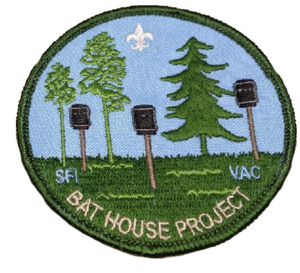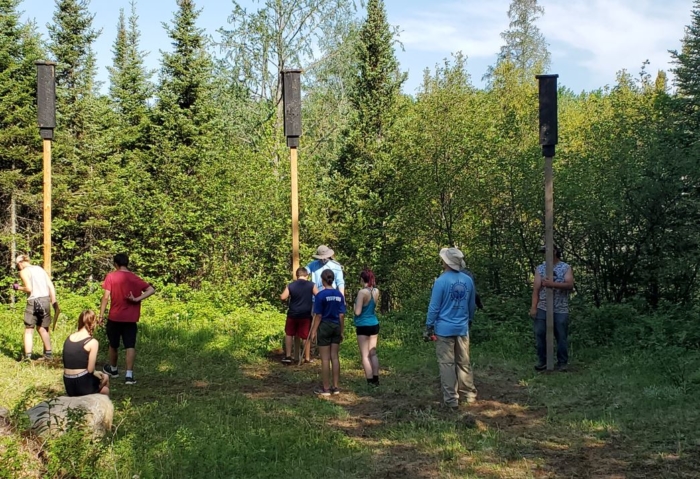
The project kicked off in the fall of 2020 and took place over multiple days—and eventually many months, as Scouts initially built the boxes made of native tamarack trees before work on the project unexpectedly paused because of a surprise snowstorm and COVID-19 restrictions on gatherings.
SFI-certified organization Norbord (now West Fraser) donated the timber necessary to create the bat box components, and as Scouts initially built the boxes in the fall, they learned about WNS and its impact on local bat populations from educational materials donated by Bat Conservation International. In the spring of 2021, when the Scouts were able to safely gather to erect the bat boxes, an auger drilled holes into Minnesota Power-owned land, they installed the boxes and cemented them firmly in place.
“We’re helping the Scouts understand that bats are not something to be afraid of—something that’s not scary,” said Michael Jenkins, Executive Director for Voyageur Scouts. “They’re learning that bats are very, very important to our environment.”
Minnesota SFI Implementation Committee Coordinator and Vice President of Forest Policy for the Minnesota Forest Industries, Rick Horton, said the goal of the boxes is to help the bats survive and thrive for generations to come—as well as to educate the Scouts and general public. Each bat box pole included a 9” x 12” sign explaining why bats matter, the risk of WNS, and the role of forest management in bat conservation. Though habitat is not a factor in the decline of forest bats in the Duluth area, the hope is that by increasing healthy habitat options and reducing predation bats can begin to improve their populations.
In the future, the project aims to continue monitoring the use of the bat boxes using tools that record bat acoustics and sharing results. Whether acting as pollinators, seed spreaders, or pest control, bats are an important element of forest ecosystems. By educating and encouraging youth to learn about the importance of bats and supporting healthy bat habitat, the Scouts will hopefully continue to serve as bat ambassadors, helping combat common misinformation about our flying friends.

Get Involved
Bats live almost everywhere on Earth, so no matter where you call home, it’s likely that there are local bat species living nearby! Support bats and join the Scouts in aiding bat conservation efforts by getting involved with Bat Week! Annually timed to coincide with Halloween, there’s no better time to take action and share why forest lovers should celebrate Bat Week. SFI’s award-winning environmental education initiative, Project Learning Tree, has assembled a page of free crafts, activities, coloring pages, and much more to share with your children and inspire an appreciation for bats at any age.
Build your own bat box
Are you thinking about building your own bat box? Not all boxes are considered equal by both bats and forests! Consider supporting bat conservation efforts by installing a bat box made of SFI-certified wood at your work, home, or nearby school, but be sure to follow detailed instructions to provide the best home. Some tips to get you started:
- Bats prefer roosts mounted on buildings or structures in cooler climates and boxes mounted to poles in warmer climates. You may also need to stain the bat box a dark color to help bats stay warm.
- Bat boxes are best installed 20 to 30 feet from the nearest trees (where predators will wait) and 10 to 20 feet from the ground or vegetation below the box.
- The more boxes, the better: bats prefer to live where there are at least three boxes grouped together.
- Bat Conservation International (BCI) has free designs for three different types of roosts: single chamber, four-chamber, and two chamber rocket boxes (the last of which are the same designs used in the Scout project—follow along the tutorial from Minnesota SFI Implementation Committee Coordinator Rick Horton here.)
Learn more about the Scouts’ project by exploring the following links:
- 9, 2020 | https://www.duluthnewstribune.com/news/science-and-nature/6609351-Photos-Scouts-build-bat-houses-for-the-northland
- 8, 2020 |
- June 5, 2021 | https://www.wdio.com/news/boy-scouts-bat-houses-/5821194/?cat=10335
- June 5, 2021 |
- June 5, 2021 | https://www.fox21online.com/2021/06/05/local-boy-scouts-install-70-bat-boxes/
- June 5, 2021 |
